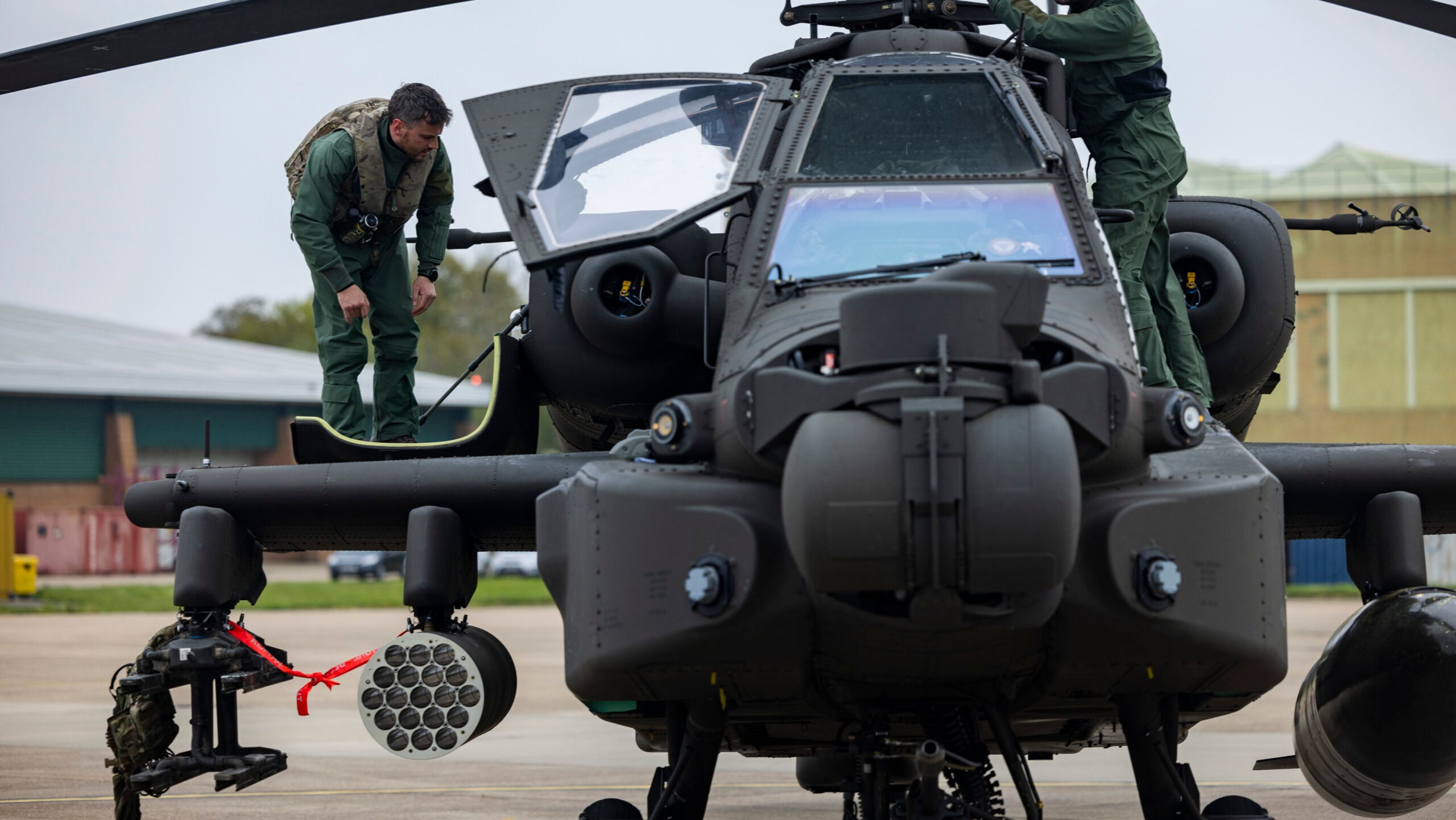
RIAT — The UK is unlikely to reverse a decision not to order MBDA Brimstone surface-to-air missiles for its AH-64E Apache Guardian attack helicopters as it moves ahead with the procurement of Lockheed Martin Joint Air-to-Ground Missiles (JAGM), according to a senior British Army official.
“I see a JAGM, [AH-64] E model synergy in terms of its design and proven use together,” Lt. Col. Rich Simcock, 3 Regt. Army Air Corp (AAC) Commanding Officer, told Breaking Defense. “I don’t currently see a situation where there’s a place for both JAGM and Brimstone in UK inventory because they are subtly different munitions that do different things. From an Apache perspective, JAGM is a very capable addition to the current weapon inventory.”
The UK was cleared in 2023 by the US State Department to buy 3,000 JAGM munitions under a possible Foreign Military Sale (FMS) valued at $957 million and in support of the British Army’s order for 50 Apache Echo’s. The US Army approved JAGM to enter full rate production a year prior.
A UK MoD spokesperson said in a statement today that they had “no update to offer” on the current status of the British JAGM order. The US State Department did not immediately return a request for comment.
The initial JAGM acquisition decision served as a competitive blow to MBDA, which had long campaigned with a rival Brimstone bid for the British Army Apache effort, including successful firing trials of the munition with the aircraft. But Simcock didn’t completely close the door on potential Brimstone integration, should the powers that be deem it useful.
“I think UK [industry] might want both [JAGM and Brimstone], rather than me,” said Simcock. “If there is a case for Brimstone in the UK, that suits an agenda for UK procurement and delivery and build and it has a specific proven purpose and effect for an air platform, I think that’s brilliant.”
In addition to future integration of JAGM, UK Apache’s also carry Hellfire missiles, 70mm Hydra rockets and 30mm automatic cannons.
Discussing interest in new weapons for the helicopter, Simcock noted that the British Army is in a “wait and see” phase. As a new addition, the US Army, for example, will start to field Israeli Spike NLOS air-to-surface missiles on their Apache fleet later this year.
Meanwhile, all British military services and industry are eagerly awaiting results from the recently commissioned Strategic Defence Review (SDR), set to report to lawmakers in “the first half of 2025,” to learn of strategic priorities and procurement changes. The new centre-left Labour government formally launched the SDR earlier this week, promising a “new era” of defense.
“I have the current munition stockpile that we have in the UK inventory, and we are focused on training our people to be adept at employing those munition types,” added Simcock.
A total of 38 Apache aircraft have so far been delivered to the UK with a next tranche to begin in the autumn.
The Lesson Not To Over-Play Ukraine Lessons
The British Army declared the Echo operationally “ready” in October 2023, while also explaining at the time that 3 Regt. AAC had proven “its core role” of providing an aviation deep attack battlegroup during Exercise Iron Titan. The battlegroup involved collaboration between 3 Regt. AH-64E Apache’s and Wildcat helicopters of 1 Regt AAC, to support the 3rd UK division, the British Army’s warfighting division.
Simcock said the Apache gives the British Army “the sort of capability that we want through for the next few decades,” and pushed back on the idea that the Ukraine war, which has witnessed a trend of helicopters being shot down at low level and short range, showed that the utility of rotorcraft on the modern battlefield is questionable.
“I would suggest that some of the lessons from Ukraine are useful, but maybe not all are entirely representative of how modern aviation can be used in the battlefield, and therefore we should be judicious about what evidence we use to draw conclusions from,” he said.
“I still believe that if we look at where we were a few years ago, where predominantly crewed systems [were valued] and we look at what the future may hold in terms of, more uncrewed systems, there is a transition happening and we are somewhere on that journey.”
He noted that as a key priority, he must ensure that as part of an Aviation Brigade Combat Team, “the right people with the right mindset” are capable of working with information “wherever it’s coming from on the battlefield, and that could be a strategic level drone, a satellite, all the way down to a tactical drone.”
Simcock added that “having enough awareness of the battlefield, such that your doctrine and your tactics can accommodate them, I think is key to generating the capacity you need to deliver the outcomes and decisions that you want, but I’m not in the space of of signing off crewed helicopters on the basis of what we’ve seen in the mainstream media from Ukraine.”